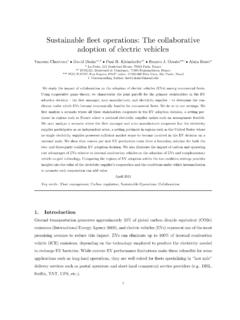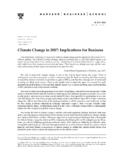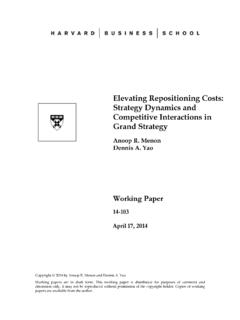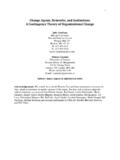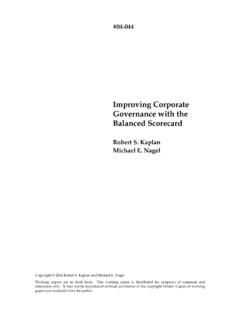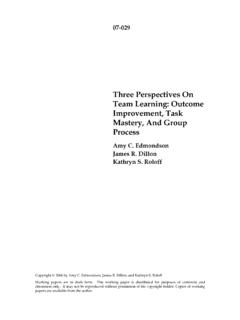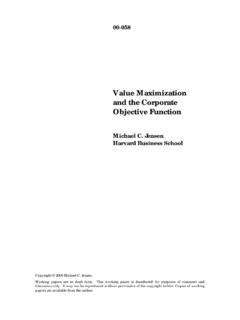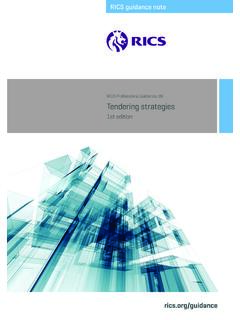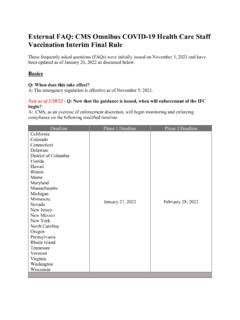Transcription of From Strategy to Business Models and to Tactics
1 Copyright 2009 by Ramon Casadesus-Masanell and Joan Enric Ricart Working papers are in draft form. This working paper is distributed for purposes of comment and discussion only. It may not be reproduced without permission of the copyright holder. Copies of working papers are available from the author. From Strategy to Business Models and to Tactics Ramon Casadesus-Masanell Joan Enric Ricart Working Paper 10-036 From Strategy to Business Models and to Tactics * Ramon Casadesus-Masanell Joan Enric Ricart November 2009 Abstract The notion of Business model has been used by Strategy scholars to refer to the logic of the firm, the way it operates and how it creates value for its stakeholders. On the surface, this notion appears to be similar to that of Strategy . We present a conceptual framework to separate and relate Business model and Strategy . Business model, we argue, is a reflection of the firm s realized Strategy .
2 We find that in simple competitive situations there is a one-to-one mapping between Strategy and Business model, which makes it difficult to separate the two notions. We show that the concepts of Strategy and Business model differ when there are important contingencies upon which a well-designed Strategy must be based. Our framework also delivers a clear separation between Tactics and Strategy . This distinction is possible because Strategy and Business model are different constructs. * We thank the Editors and two anonymous Reviewers as well as participants in the Long Range Planning conference on Business Models held at the Cass Business School in December 2008. We have benefited from discussions with MBA students and executive education program participants at HBS and IESE where we teach a second-year, case-based elective titled Competing through Business Models .
3 Casadesus-Masanell is grateful to the HBS Division of Research and IESE Business School s Public-Private Sector Research Center. Ricart is grateful to the Carl Schr eder Chair at IESE. All errors are only ours. Associate Professor, Harvard Business School. Morgan Hall 233. Boston, MA 02163, USA. Email: Carl Schr eder Professor of Strategic Management, IESE Business School. Avenida Pearson, 21. 08034 Barcelona, Spain. Email: 1 I. Introduction The field of Strategy has evolved substantially in the past twenty-five years. Firms have learned to analyze their competitive environment, define their position, develop competitive and corporate advantages, and understand threats to sustaining advantage in the face of challenging competitive threats. Different approaches including industrial organization, the resource-based view, dynamic capabilities, and game theory have helped academicians and practitioners understand the dynamics of competition and develop recommendations on how firms should define their competitive and corporate strategies.
4 However, drivers such as globalization, deregulation, or technological change, just to mention a few, are profoundly changing the competitive game. Scholars and practitioners agree that the fastest growing firms in this new environment appear to have taken advantage of these structural changes to compete differently and innovate in their Business Models . IBM s 2006 and 2008 Global CEO Study, for example, show that top management in a broad range of industries are actively seeking guidance on how to innovate in their Business Models to improve their ability to both create and capture Advances in information and communication technologies have driven the recent interest on Business model innovation. Many e-businesses constitute new Business Models . Shafer, Smith, and Linder present twelve recent definitions of Business model and find that eight are related to e- Business . Of course not all Business model innovations are IT-driven; other forces, such as globalization and deregulation, have also resulted in new Business Models and fed the interest on this 2 New strategies for the bottom of the pyramid in emerging markets have also steered researchers and practitioners towards the systematic study of Business Models .
5 Academicians working in this area agree that for firms to be effective in such unique environments, they need to develop novel Business Models . In fact, socially motivated enterprises that aim to reach the bottom of the pyramid constitute an important source of Business model Although it is uncontroversial that for organizations to thrive managers must have a good understanding of how Business Models work, the academic community has, so far, only offered early insights on the issue. In truth, there is not yet agreement on what are the distinctive features of superior Business Models . We believe that the dispute has arisen, in part, because of a lack of a clear distinction between the notions of Strategy , Business model, and Tactics . The purpose of this paper is to contribute to this literature by presenting an integrative framework to distinguish and relate the concepts of Business model, Strategy , and Tactics . Put succinctly, Business model refers to the logic of the firm, the way it operates and how it creates value for its stakeholders.
6 Strategy refers to the choice of Business model through which the firm will compete in the marketplace. Tactics refers to the residual choices open to a firm by virtue of the Business model that it employs. To integrate the concepts of Strategy , Business model, and Tactics , we introduce the generic two-stage competitive process framework depicted in Figure 1. In the first stage, firms choose a logic of value creation and value capture (choose their Business model). In the second stage, firms make tactical choices guided by their goals (in most cases, goals entail some form of stakeholder value maximization). 3 ------------------------------------ Insert Figure 1 around here ------------------------------------ Figure 1 presents our organizing framework: the object of Strategy is the choice of Business model, and the Business model employed determines the Tactics available to the firm to compete against, or cooperate with, other firms in the marketplace.
7 The paper is organized as follows. In Section II we define and discuss the notion of Business model and present a tool to represent Business Models . In Section III we study the second stage of the framework. Specifically, we present and discuss the notion of Tactics and relate it to that Business model. In Section IV, we move on to discussing the first stage, the Strategy stage. Section V revisits the generic two-stage competitive process framework to integrate the three notions: Strategy , Business model, and Tactics . We discuss the connection between Strategy and Business model and argue that both notions can be clearly separated. We develop a detailed example in Section VI. Section VII concludes. II. Business model Defining Business model The origins of the expression Business model can be traced back to the writings of Peter Drucker, but the notion has gained prominence only in the last decade.
8 While Business model has been part of the Business jargon for a long time, Markides points out that there is no widely accepted 4 Magretta defines Business Models as stories that explain how enterprises work. This author goes back to Peter Drucker and defines a good Business model as the one that provides answers to the following two questions: Who is the customer and what does the costumer value? What is the underlying economic logic that explains how we can deliver value to customers at an appropriate cost? Magretta s implicit idea is that Business model refers to the logic by which the organization earns money. While not formal, Magretta s approach highlights two fundamental questions that any Business model should answer, one related to the value provided to the customer and the other to the organization s ability to capture value in the process of serving While Magretta s definition is broad but imprecise, Amit and Zott s is less ample (as it focuses on e-businesses) but precise.
9 These authors review the contributions of several theories including virtual markets, Schumpeterian innovation, value chain analysis, the resource-based view of the firm, dynamic capabilities, transaction cost economics, and strategic networks. As they point out, every theory contributes elements to the notion but none, by itself, explains completely the nature of Business Models . Amit and Zott (2001) analyze a sample of and European e- Business Models to highlight the drivers of value creation and present the following integrative definition: A Business model depicts the content, structure, and governance of transactions designed so as to create value through the exploitation of Business opportunities. Transaction content refers to the goods or information being exchanged, as well as to the resources and capabilities required. Transaction structure refers to the parties that participate, their links, and the way they choose to operate.
10 Finally, transaction governance refers to the way flows of information, resources, and goods are controlled by the relevant parties, the legal form of organization, and the incentives to the 5 Building on their original definition, Zott and Amit (2010) propose an activity system perspective for the design of Business Models . They argue that activity systems capture the essence of Business Models and propose two sets of aspects that Business model designers need to consider: design elements (content, structure, and governance) that describe the architecture of the activity system, and design themes (novelty, lock-in, complementarities, and efficiency) that describe the sources of value creation of the activity The common thread across all of these approximations to the notion of Business model is captured well by Baden-Fuller, MacMillan, Demil, and Lecocq when they define Business model as the logic of the firm, the way it operates and how it creates value for its stakeholders.
